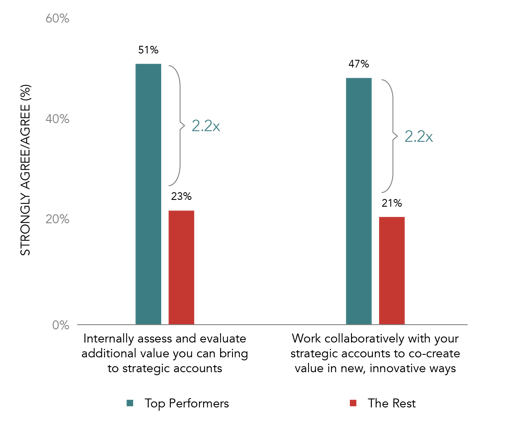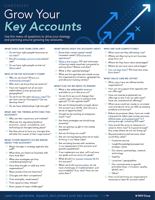What Is Strategic Account Management?
Strategic account management (SAM) is a systematic approach to managing and growing an organization's most important customers (often referred to as key accounts) to maximize mutual value and achieve mutually beneficial goals.
Top sellers and organizations excel at growing business and revenue through their existing accounts. Top Performers in Strategic Account Management have drastically better account growth—they’re 3.1x more likely to grow revenue by 20% or more in existing accounts compared to others.
Some sales leaders believe that effective strategic account management is largely related to the strength of product and service offerings. The companies that grow their accounts the most must have superior offerings that keep customers coming back for more, right?
Wrong.
In a RAIN Group Center for Sales Research study, we surveyed 472 sales leaders and asked them the rate at which they agree with the following statement: "The potential for revenue growth in our current offering set is exceptional." Of the 72 factors we studied, this ranked 72nd in difference between Top Performers and The Rest.
In fact, there was no statistical difference between the two groups regarding the growth potential of the current offering set. If it isn't the offerings, then what, specifically, makes some organizations so much better at growing their accounts?
To find out, we conducted a major study of 397 organizations with formal strategic account management functions. Top Performers in this study, Top Performance in Strategic Account Management, had stronger revenue growth, margin growth, and satisfaction growth in their named strategic accounts than The Rest.
The secret lies in both the capabilities of their strategic account managers and their ability to establish an effective SAM process.
What Is a Strategic Account Manager?
A strategic account manager is responsible for identifying opportunities to add value for key accounts and nurturing the client relationship. They work to maintain customer service, customer satisfaction, and retention. With a thorough knowledge of buyer objectives and needs, they’re responsible for guiding them toward innovative solutions.
Read on to learn what it takes for sellers and organizations to maximize client value and loyalty through strategic account management.
How to Excel at Strategic Account Management
Where Do Top Performers in Strategic Account Management Excel?
SAM is at its best when organizations have structures in place to support it. An ad hoc approach doesn’t cut it; support for SAM should be consistent, with a defined approach and established processes to measure and grow.
It’s a worthy investment. These standout organizations enjoy higher revenue, profits, and customer satisfaction than others.
They stand out in four areas:
- Right team and right skills: Top Performers invest in training strategic account managers to drive revenue. Their teams focus on generating new ideas, pursuing growth, and ensuring planning and execution.
- Process discipline: Top Performers are significantly more likely to have a process for strategic account management. This includes related processes for uncovering untapped value and developing their team’s SAM skills.
- Strong account plans: Not only are Top Performers 2.5x more likely to have effective processes for building strategic account plans, they’re more likely to execute on them.
- Accountability: The culture and planning of these organizations keeps strategic account managers on track. They fulfill the SAM roles necessary to keep new opportunities moving.
The Strategic Account Management Competency Model
Among our key findings are that Top Performers in Strategic Account Management have strategic account managers who:
![]()
- Drive Value: The best strategic account managers grow accounts because they drive value for buyers proactively.
- Ask How, Who, and What: They ask the questions that get to the heart of expanding and winning opportunities with existing accounts.
- Plan: Top Performers are more than 2x as likely to have an effective process for growing and protecting strategic accounts. It may be cliché, but "he who fails to plan, plans to fail" still applies in strategic account management.
- Play the 6 Strategic Account Management Roles much better than The Rest.
Together, these make up our Strategic Account Management Competency Model. While we cover the 6 strategic account management (SAM) roles in detail here, in this article we'll cover the other components of the model.
Read: Competencies of Strategic Account Managers
Driving Value
The strategic account managers (SAMs) that grow accounts do so because they proactively drive value for buyers. Staying proactive is important, as too many SAMs view their role as winning opportunities that essentially fall on their desks.
However, most account growth lies in the value SAM teams can drive that buyers wouldn't be aware of unless sellers themselves raised the ideas. Though 75% of purchases are strategic, sellers only bring ideas 14% of the time.
If you can clearly define how your accounts can benefit from expanding or evolving their relationship with you, you're much more likely to successfully communicate that value to account stakeholders.
The key question then becomes: how effective is your company's process for identifying and delivering this additional value? In our research, we examined this from two critical angles:
- Internal Value Discovery: How effectively companies use their own teams to brainstorm and identify new ways to bring value to accounts
- External Value Co-creation: How successfully companies collaborate with their strategic account stakeholders to innovate and create new value together
The data around driving value supports the importance of doing it. We found that when SAMs drive value, companies are much more likely to be in the Top Performer group.
When we asked about the effectiveness of company processes to drive value, we found that Top Performers are 2.2x more likely to do so. They're better at internally assessing the myriad of ways they can drive additional value at strategic accounts and working collaboratively with strategic accounts to drive value in new, innovative ways.
|
Figure 1. Effectiveness of Company Process to Drive Value |
 |
Ask How | Who | What
If you're going to drive value, you need to answer three questions:
1. How are you going to drive value for the account?
If you're going to drive value, you need new and innovative ideas for how to do that, and you need practical support for making sure the ideas can become reality.
The best SAMs have a strong process for discovering value internally and can bring those conversations to buyers.
2. Who is important in driving this value?
You need to identify the stakeholders that should be involved and what their respective roles are to drive value both on your team and the account's.
SAMs are tasked with building and maintaining strong connections with their buyers. You should be thinking about how to align your goals with the buyers and build relationships with stakeholders.
3. What do you need to do to make additional value come to life?
If you're going to drive value proactively, a variety of people will need to play a variety of roles. Everyone on your team needs to create action plans that hold people accountable, detail what needs to be done, and guides the whole strategic account growth process.
Rarely does a single individual play all 6 strategic account management roles. You should know who on your team is responsible for each of the roles.
Building a Strategic Account Plan
The hub that connects the How | Who | What concepts is a strategic account plan. You may think that this is a given, but only 21% of The Rest have an effective process for growing and protecting strategic accounts compared to 53% of Top Performers.
And when it comes to the 32 strategic account manager competencies we studied, the four worst across all respondents related to strategic account planning:
- Ensure account plans are current
- Vet account plans to ensure they’re solid and defensible
- Ensure account plans are thorough
- Create compelling and effective written plans
Top Performers are markedly better, however.
|
Figure 2. Account Managers Lead the Account |
Figure 3. Account Managers Ensure the Execution |
 |
 |
 |
|
57 Questions to Help You Build Your Key Account Growth Plan |
How to Connect with Key Accounts
If you’re selling to a key account, you know them already. And they know you. You’re important to each other. You’ve built trust. That’s a very strong platform—one you should be careful to protect.
At the same time, most recognize they can and should be doing more work with their key accounts. No one else is going to make sure the client receives maximum business value from their relationship with your company. It’s up to you to know your accounts, understand their needs, and pursue opportunities.
Yet many sellers, especially seller-doers such as at services firms, may be averse to outreach. They may think, "I shouldn’t bother my clients," and "I don’t want to upset their trust. They can’t see me too as self-interested, and selling to them does that."
This thinking is misguided.
Let’s assume you’ve already led a solid internal value discovery session. You have a set of ideas for how you should expand account relationships by adding more value.
Now that you’ve carefully explored working with the client in more ways that will help them be more successful, the outreach doesn’t need be complicated or contrived. When it goes something like this, it tends to work just fine. Any channel is acceptable, depending on buyer preferences.
Email Example
Joanna,
[Insert pleasantries / rapport here.]
Last week the team and I got to talking about the work we’re doing in A, B, and C. In fact, we ended up having a meeting to discuss a few things we’ve been seeing as the project has moved along.
At the meeting, we generated some ideas about improving X and Y—something you and I have, I realize, never talked about—and I think we came up with some really interesting possibilities. In fact, with one of them, we think it’ll speed up the process quite a bit, which I know is something you’re always looking to do.
After getting pretty deep into the discussion, we thought: this meeting would be much better if Joanna and Steve were here. We know quite a bit about your situation, but can’t fully flesh out the ideas without your help and collaboration.
If you’d like, we can swing by sometime in the next few weeks to discuss. If so, we’ll write up an agenda to get us started so you can get the sense of the big picture of a few key areas we were talking about.
Thoughts?
Best regards,
[Name]
There are innumerable varieties of length, tone, and specifics you can communicate, but the ideas are to:
- intrigue them with the possibility of creating value that ’s really worthwhile to them,
- with a straightforward approach,
- that invites collaboration.
These three points are critical for your messaging if you want to generate more leads with key accounts.
If this were cold prospecting, you might see advice to include something like, “We’ve been able to help organizations like X and Y to increase the speed of their new location openings by 21%, saving an average of $400k per opening.”
This can be a good approach when there isn’t an existing relationship, but it tends to be overkill for someone you know. If you have a good relationship, they should say yes to a meeting, or at least ask to find out more, and you can take it from there.
If they ask questions, let them know the gist of what you’re thinking. You might say that you’ve been working with another client, and a few innovations you’ve produced there are generating great results like you mentioned. Keep the tone of the initial outreach conversational.
It’s a revelation and a relief for many sellers to know that they can (and should) reach out to existing clients with a conversational and straightforward approach that doesn’t make them feel too salesy. This approach won’t upset the relationship, generates more leads, and fills the pipeline with new business opportunities.
The Power of Strategic Account Management
There's no question that strong account plans and planning correlate significantly to Top Performance. So significantly, in fact, that the strategic account plan is the hub that connects the spokes of the Strategic Account Manager Competency Model.
At RAIN Group, we have honed this model over many years of working with large and mid-size organizations to optimize their strategic account management success, and through our benchmark research reports in both selling and strategic account management.
If you want to make your strategic account management a success, attend to each of areas in the SAM Competency Model.








